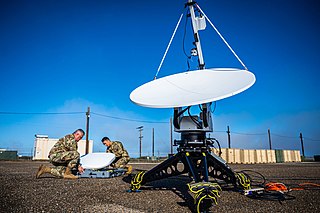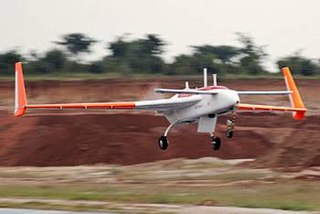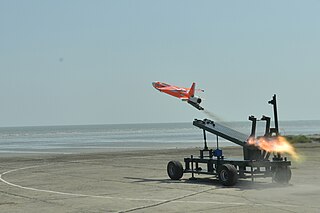
An unmanned aerial vehicle (UAV), or unmanned aircraft system (UAS), commonly known as a drone, is an aircraft with no human pilot, crew, or passengers onboard. UAVs were originally developed through the twentieth century for military missions too "dull, dirty or dangerous" for humans, and by the twenty-first, they had become essential assets to most militaries. As control technologies improved and costs fell, their use expanded to many non-military applications. These include aerial photography, area coverage, precision agriculture, forest fire monitoring, river monitoring, environmental monitoring, weather observation, policing and surveillance, infrastructure inspections, smuggling, product deliveries, entertainment, and drone racing.

Electromagnetic warfare or electronic warfare (EW) is warfare involving the use of the electromagnetic spectrum or directed energy to control the spectrum, attack an enemy, or impede enemy operations. The purpose of electromagnetic warfare is to deny the opponent the advantage of—and ensure friendly unimpeded access to—the EM spectrum. Electromagnetic warfare can be applied from air, sea, land, or space by crewed and uncrewed systems, and can target communication, radar, or other military and civilian assets.

Israel Aerospace Industries, is Israel's major aerospace and aviation manufacturer, producing aerial and astronautic systems for both military and civilian usage. It has 14,000 employees as of 2021. IAI is state-owned by the government of Israel.

Unmanned aerial vehicles (UAVs) include both autonomous drones and remotely piloted vehicles (RPVs). A UAV is capable of controlled, sustained level flight and is powered by a jet, reciprocating, or electric engine. In the twenty-first century, technology reached a point of sophistication that the UAV is now being given a greatly expanded role in many areas of aviation.

The DRDO Nishant - is an unmanned aerial vehicle (UAV) developed by India's Aeronautical Development Establishment (ADE), a branch of Defence Research and Development Organisation (DRDO) for the Indian Armed Forces. The Nishant UAV is primarily tasked with intelligence gathering over enemy territory and also for reconnaissance, training, surveillance, target designation, artillery fire correction, damage assessment, ELINT and SIGINT. The UAV has an endurance of four hours and thirty minutes. Nishant has completed development phase and user trials. However, further development of the project was cancelled after all of the four prototypes and production UAVs crashed due to various and unknown reasons.

Lakshya is a remotely piloted high speed Indian target drone system developed by the Aeronautical Development Establishment (ADE) of DRDO. A variant Lakshya-1 is used to perform discreet aerial reconnaissance of battlefield and target acquisition.

The DRDO Rustom is a family of medium-altitude long-endurance (MALE) unmanned air vehicle (UAV) being developed by the Defence Research and Development Organisation (DRDO) for the three services, Indian Army, Indian Navy and the Indian Air Force, of the Indian Armed Forces. Rustom is derived from the NAL's LCRA developed by a team under the leadership of late Professor Rustom Damania in the 1980s. The UAV will have structural changes and a new engine.

Ghatak (pronounced: gʰɑːt̪ək; lit. 'Deadly' in Sanskrit), initially designated as Indian Unmanned Strike Air Vehicle (IUSAV), is an autonomous jet powered stealthy unmanned combat aerial vehicle (UCAV), being developed by Aeronautical Development Establishment (ADE) of the Defence Research and Development Organisation (DRDO) for the Indian Air Force. The design work on the UCAV is to be carried out by Aeronautical Development Agency (ADA). Autonomous Unmanned Research Aircraft (AURA) was a tentative name for the UCAV. Details of the project are classified.
ZALA Aero Group is a Russian company specialising in unmanned aerial vehicle (UAV) development, located in Izhevsk, Russia. ZALA Aero has provided UAV systems for several sectors of the Russian government, including the Ministry of Defence, and has also won contracts to supply UAVs to foreign countries. The company's in-house design and production projects include a variety of systems related to UAV design, manufacture and operation, including autopilots, airframes, mechanical and pneumatic catapults, launchers, payloads and communication technologies. ZALA Aero is the only Russian company producing unmanned helicopters, portable anti-drone EW systems and a VTOL drone.
Ulka is an air-launched expendable target drone of India.

Barak 8, also known as LR-SAM or MR-SAM and Barak MX, is an Indian-Israeli jointly developed surface-to-air missile (SAM) system, designed to defend against any type of airborne threat including aircraft, helicopters, anti-ship missiles, and UAVs as well as ballistic missiles, cruise missiles and combat jets. Both maritime and land-based variants of the system exist.

Sudarshan is an Indian laser-guided bomb kit, developed by Aeronautical Development Establishment (ADE), a DRDO lab with technological support from another DRDO lab Instruments Research and Development Establishment (IRDE), for the Indian Air Force (IAF).
The Imperial Eagle is an Indian light-weight mini-unmanned aerial vehicle (UAV) developed by the Aeronautical Development Establishment, National Aerospace Laboratories and supported by private vendors. Its primary users will be the National Security Guard and the military services.

The DRDO Abhyas is a high-speed expendable aerial target being built by the Aeronautical Development Establishment (ADE) of the Defence Research and Development Organisation (DRDO) for the Indian Armed Forces.
HAL RUAV-200 is an unmanned rotorcraft project being developed by Hindustan Aeronautics Limited for the Indian Army and the Indian Navy.
Aeronautical Test Range (ATR), Chitradurga is an out-door testing and evaluation facility set up by the Defence Research and Development Organisation (DRDO) exclusively for unmanned and manned aircraft. The ATR is under the command of the Aeronautical Development Establishment (ADE).

The Tactical Airborne Platform for Aerial Surveillance Beyond Horizon-201 or TAPAS BH-201(Sanskrit: तपस्; lit. Heat) is a medium-altitude long-endurance (MALE) unmanned aerial vehicle (UAV) being developed in India by Aeronautical Development Establishment (ADE) on the lines of General Atomics MQ-1 Predator.
The HAL Combat Air Teaming System (CATS) is an Indian unmanned and manned combat aircraft air teaming system being developed by Hindustan Aeronautics Limited (HAL). The system will consist of a manned fighter aircraft acting as "mothership" of the system and a set of swarming UAVs and UCAVs governed by the mothership aircraft. A twin-seated HAL Tejas is likely to be the mothership aircraft. Various other sub components of the system are currently under development and will be jointly produced by HAL, National Aerospace Laboratories (NAL), Defence Research and Development Organisation (DRDO) and Newspace Research & Technologies.
This article consists of projects of the Defence Research and Development Organisation (DRDO).











